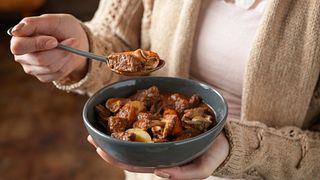Beef Choices
Labels. There's a lot of them and that means a lot of choices. We’ve got everything you need to know to choose the right beef for you the next time you're making a decision.
Decisions, Decisions
You're looking for a lean cut for a weeknight family dinner or a large, tender cut for your holiday roast. You’re reading all the labels and still don’t know what they mean. You’re scratching your head over the nutrition content of grass-finished beef versus grain-finished beef. You’re wondering what it takes to make the cut and get that Prime sticker.
Whatever the label or question, we’ve got a breakdown of {a little more than} the basics to help you out the next time you're at the meat case.
Reading Labels:
Like the farmers and ranchers who choose how best to raise their cattle for beef, you have choices when it comes to the beef you buy. Cattle are raised responsibly and all beef is wholesome and nutritious – but you may see a variety of statements that reflect different production practices on beef packages in your grocery store or on a menu. The U.S. Department of Agriculture (USDA) approves these labels for beef based on specific criteria. Here's a few of the most common labels you'll see in stores.
Certified Organic:
Certified organic beef, designated by the official label, comes from cattle that have never received any antibiotics or growth-promoting hormones. These cattle may be spend time at the feedyard and can be either grass-finished or grain-finished as long as the USDA’s Agriculture Marketing Service certifies the feed as 100% organically grown.
Naturally Raised:
Naturally raised beef comes from cattle that have never received antibiotics or growth-promoting hormones. This beef may spend time at a feedyard and can be either grain-finished or grass-finished.
Antibiotic-Free:
Or Raised Without Antibiotics, means just that. Cattle in these programs are certified to have never been given antibiotics. But there's more to the story: By law, no meat sold in the U.S. can contain antibiotic residues and the FDA is in charge of testing to ensure that all meat is residue-free.
Grass and Grain Diets:
You’ve likely seen various labels showing that beef is “natural” or “grass fed.” But what do these labels mean? All cattle spend a majority of their lives eating grass on pastures. But beef can be finished in a variety of ways, giving you choices when at the meat case in your local grocery store or at a restaurant. Let’s explore the difference between various beef choices including grass-finished and grain-finished beef as well as some other popular labels.
Grass-Fed Beef:
Great news: All cattle are grass-fed for the majority of their lives.
Grass-finished Beef:
Grass-finished cattle spend their entire lives grazing and eating from pastures. These cattle may also eat forage, hay or silage at the feedyard. As well, grass-finished cattle may or may not be given FDA-approved antibiotics to treat, prevent or control disease and/or growth-promoting hormones.
grain-finished Beef:
Grain-finished cattle, like grass-finished, spend the majority of their lives eating grass and forage in pastures. When beef is grain-finished, cattle are free to eat a balanced diet of grain, local feed ingredients, like potato peels, apples, or grape pomace, and hay or forage at the feedyard. Similarly, grain-finished cattle may or may not be given FDA-approved antibiotics to treat, prevent or control disease and/or growth-promoting hormones.
Beef Grades:
Beef grading sets the standards for the various quality levels of beef. The beef grading program uses highly trained specialists and sometimes grading instruments to determine the official quality grade. Beef quality grading is voluntary and administered by the USDA and paid for by beef packers. The grade is primarily determined by the degree of marbling — the small flecks of fat within the beef muscle. Marbling provides flavor, tenderness and juiciness to beef and improves overall palatability. Other grading factors include animal age, and color and texture of the muscle. Let's explore the different beef grades.
Prime:
Prime beef is produced from young, well-fed cattle. It has abundant marbling, is produced in smaller quantities than other grades, and is often sold in hotels and restaurants. Prime roasts and steaks are excellent for roasting, grilling or broiling.
Choice:
Choice beef is high quality and produced in highest quantity, but has less marbling than Prime. Choice roasts and steaks, especially from the rib and loin, will be very tender, juicy and flavorful. They are suited for roasting, grilling and broiling. Less tender cuts are perfect for slow-cooking.
Select:
Select beef is slightly leaner than Prime and Choice because it has less marbling. It can lack some tenderness, flavor and juiciness as compared to the higher grades. Select grade beef often benefits from slow-cooking or from marination prior to grilling or broiling.



